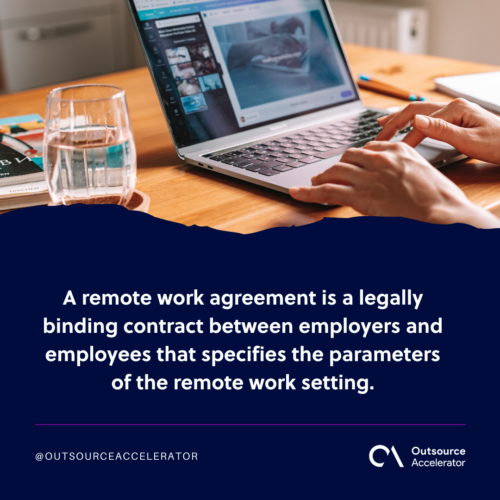Remote work agreement: A definitive guide

While the COVID-19 pandemic has accelerated the trend toward working remotely, it also stirs some concerns regarding employees’ well-being and productivity.
For this reason, several businesses are implementing remote work policies to lay down firm ground rules and precise expectations.
This article discusses the remote work agreement and how this agreement can contribute to the long-term success of your business.
What is a remote work agreement?
A remote work agreement is a legally binding contract between employers and employees that specifies the parameters of the remote work setting.
This written remote work policy aids in ensuring the remote work arrangement goes well by laying up clear expectations, obligations, and rules for both employers and employees.

5 key components of remote work agreement
Here are the five key components and considerations when creating a remote work agreement:
1. Scope of remote work arrangement
Simply put, this section in the remote work agreement presents the detailed job description, including the duties and responsibilities of the workers. This also enumerates the employer’s expectations from the staff.
The scope of the remote work arrangement may include:
- Explanatory sentences that explain why, how, where, and how frequently the activities and obligations are carried out
- Direct or indirect accountability
- The nature and extent of the company’s budgetary or financial duties
- List of work tasks that represent the employment criteria
2. Work hours and availability
The second most significant part of a remote work agreement is stating the employees’ work hours and work days. This part must specifically explain the days and hours the individual is expected to work.
Employers may leave a blank section on this part so remote employees can note their availability for meetings and long-hour communications.
3. Communication and collaboration tools
Communication and collaboration tools are essential in a remote work setting. Since colleagues are miles apart from one another, they need to have a reliable means to connect and brainstorm ideas.
A remote work agreement should state the specific communication and collaboration tools required for the remote team.
4. Data security and confidentiality
Data security and confidentiality are critical in a work-from-home environment. This section and the actions that will be taken to safeguard sensitive information should be included in a remote work agreement.
Additionally, the part must mention the legal consequences should there be any violation of this rule. This helps to ensure that both the employer and the employee will uphold their respective responsibilities in keeping sensitive company information private.
5. Performance evaluation and metrics
The remote work agreement’s performance evaluation and metrics section contains the criteria to assess the employee’s overall performance for regularization or promotion purposes.
The metrics should include details about what the employer or manager will do to quantify employee performance. It could be an explanation of the grading system or how the submitted tasks of the employee will be evaluated.
3 ways to craft an effective remote work agreement
Here are the three ways to craft an effective remote work agreement:
Identify the company and employee needs
Determine both the employer’s and the employee’s needs first and tailor the agreement to the demands of both parties.
This often comprises two essential employer-employee desires and needs:
- Presenting the firm’s aims for remote work
- Outlining the employee’s possible demands and preferences in a remote workplace
These two will increase the likelihood that the remote work arrangement will be effective and meet the needs of both parties.
Tailor the remote work agreement to fit specific roles
In relation to the first step, it is vital that the business tailors the remote work agreement to individual duties.
Because different positions may necessitate different remote work solutions, it is important to evaluate the specific requirements of each function. Identify the job objectives, work hours, and the tools necessary for each job function.
Including this section in the agreement allows employers to ensure that each employee has access to the resources needed for their specific role.

Address legal and compliance considerations
Do not forget the legal and regulatory considerations in the remote work arrangement. This portion assures the employees that the distant company complies with:
- Applicable labor regulations
- Data privacy guidelines
- Intellectual property restrictions
Each personnel should be accurately classified as exempt or non-exempt in this area. This involves the employer’s legal responsibility to his workers and vice versa.
With this information, employers may guarantee that their arrangement for employees to work remotely is lawful and in accordance with all applicable legislation.
Well-defined remote work agreement establishes clear expectations
A well-defined remote work agreement assures the success of the firm’s remote work arrangement. Furthermore, if your firm is slowly transitioning to remote work you may use the abovementioned considerations and ways to develop an effective remote work agreement.







 Independent
Independent




